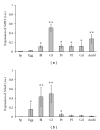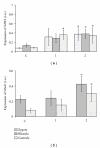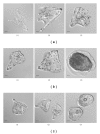Expression of Pigment Cell-Specific Genes in the Ontogenesis of the Sea Urchin Strongylocentrotus intermedius
- PMID: 21804858
- PMCID: PMC3144734
- DOI: 10.1155/2011/730356
Expression of Pigment Cell-Specific Genes in the Ontogenesis of the Sea Urchin Strongylocentrotus intermedius
Abstract
One of the polyketide compounds, the naphthoquinone pigment echinochrome, is synthesized in sea urchin pigment cells. We analyzed polyketide synthase (pks) and sulfotransferase (sult) gene expression in embryos and larvae of the sea urchin Strongylocentrotus intermedius from various stages of development and in specific tissues of the adults. We observed the highest level of expression of the pks and sult genes at the gastrula stage. In unfertilized eggs, only trace amounts of the pks and sult transcripts were detected, whereas no transcripts of these genes were observed in spermatozoids. The addition of shikimic acid, a precursor of naphthoquinone pigments, to zygotes and embryos increased the expression of the pks and sult genes. Our findings, including the development of specific conditions to promote pigment cell differentiation of embryonic sea urchin cells in culture, represent a definitive study on the molecular signaling pathways that are involved in the biosynthesis of pigments during sea urchin development.
Figures






Similar articles
-
Pigment cell differentiation in sea urchin blastula-derived primary cell cultures.Mar Drugs. 2014 Jun 27;12(7):3874-91. doi: 10.3390/md12073874. Mar Drugs. 2014. PMID: 24979272 Free PMC article.
-
Quinoid Pigments of Sea Urchins Scaphechinus mirabilis and Strongylocentrotus intermedius: Biological Activity and Potential Applications.Mar Drugs. 2022 Sep 28;20(10):611. doi: 10.3390/md20100611. Mar Drugs. 2022. PMID: 36286435 Free PMC article. Review.
-
Involvement of the cell-specific pigment genes pks and sult in bacterial defense response of sea urchins Strongylocentrotus intermedius.Dis Aquat Organ. 2013 Mar 26;103(2):121-32. doi: 10.3354/dao02570. Dis Aquat Organ. 2013. PMID: 23548362
-
Isolation of pigment cell specific genes in the sea urchin embryo by differential macroarray screening.Development. 2003 Oct;130(19):4587-96. doi: 10.1242/dev.00647. Development. 2003. PMID: 12925586
-
Possible role of translation in unfertilized sea urchin eggs.Cell Biol Int. 2023 Oct;47(10):1684-1687. doi: 10.1002/cbin.12068. Epub 2023 Jul 9. Cell Biol Int. 2023. PMID: 37422860 Review.
Cited by
-
Amelioration of endotoxin-induced uveitis treated with the sea urchin pigment echinochrome in rats.Mol Vis. 2014 Feb 7;20:171-7. eCollection 2014. Mol Vis. 2014. PMID: 24520186 Free PMC article.
-
Mechanisms of the epithelial-to-mesenchymal transition in sea urchin embryos.Tissue Barriers. 2015 Jun 17;3(4):e1059004. doi: 10.1080/21688370.2015.1059004. eCollection 2015 Oct-Dec. Tissue Barriers. 2015. PMID: 26716069 Free PMC article. Review.
-
Pigment cell differentiation in sea urchin blastula-derived primary cell cultures.Mar Drugs. 2014 Jun 27;12(7):3874-91. doi: 10.3390/md12073874. Mar Drugs. 2014. PMID: 24979272 Free PMC article.
-
Quinoid Pigments of Sea Urchins Scaphechinus mirabilis and Strongylocentrotus intermedius: Biological Activity and Potential Applications.Mar Drugs. 2022 Sep 28;20(10):611. doi: 10.3390/md20100611. Mar Drugs. 2022. PMID: 36286435 Free PMC article. Review.
-
Naphthoquinones of the spinochrome class: occurrence, isolation, biosynthesis and biomedical applications.RSC Adv. 2018 Sep 21;8(57):32637-32650. doi: 10.1039/c8ra04777d. eCollection 2018 Sep 18. RSC Adv. 2018. PMID: 35547692 Free PMC article. Review.
References
-
- Fox DL, Scheer BT. Comparative studies of the pigments some Pacific Coast echinoderms. Biological Bulletin. 1941;80:441–455.
-
- Griffiths M. A study of the synthesis of naphthaquinone pigments by the larvae of two species of sea urchins and their reciprocal hybrids. Developmental Biology. 1965;11(3):433–447. - PubMed
-
- Fedoreyev SA, Mischenko NP, Kol'tsova EA, et al. Drug, Histochrome, from the sea urchin. In: Abstracts of 5th International Marine Biotechnology Conference; 2000; Townsville, Australia. p. 53.
-
- Mishchenko NP, Fedoreev SA, Bagirova VL. Histochrome: a new original domestic drug. Pharmaceutical Chemistry Journal. 2003;37(1):48–52.
-
- Koltsova EA, Boguslavskaya LV, Maximov OV. On the functions of quinonoid pigment production in sea urchin embryos. International Journal of Invertebrate Reproduction. 1981;4:17–28.
LinkOut - more resources
Full Text Sources
Miscellaneous

